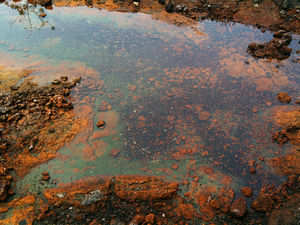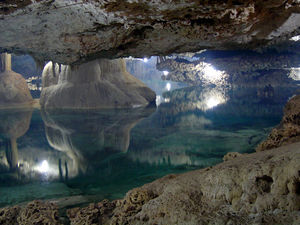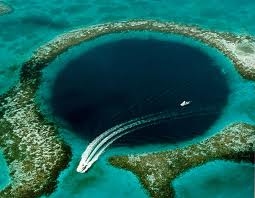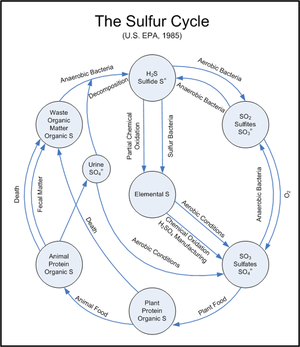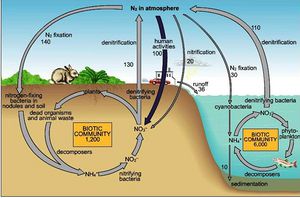Anchialine pools and cenotes: Difference between revisions
| Line 70: | Line 70: | ||
====[http://onlinelibrary.wiley.com.proxy2.library.illinois.edu/doi/10.1111/j.1462-2920.2010.02324.x/pdf "A Comparative Molecular analysis of Water-filled Limestone Sinkholes in North-eastern Mexico"]==== | ====[http://onlinelibrary.wiley.com.proxy2.library.illinois.edu/doi/10.1111/j.1462-2920.2010.02324.x/pdf "A Comparative Molecular analysis of Water-filled Limestone Sinkholes in North-eastern Mexico"]==== | ||
Researchers are using new methods to study cenotes in | Researchers are using new methods to study cenotes in Sistema Zacaton in north-eastern Mexico. Microbial mat communities were studied using comparative analysis of small-subunit 16S rRNA gene sequences. Genes associated with methanogenesis, sulfate reduction and anaerobic ammonium oxidation were also identified and studied. | ||
====[http://ijr.sagepub.com.proxy2.library.illinois.edu/content/29/6/748.full.pdf+html "Autonomous Exploration and Mapping of Flooded Sinkholes"]==== | |||
NASA conducted an experiment in which flooded cenotes were mapped using the DEPTHX )Deep Phreatic Thermal Explorer) autonomous vehicle in Sistema Zacaton in Mexico. Three-dimensional maps of cenotes were constructed and environmental data, imagery, water samples, and core samples were taken from the cenotes in this region. | |||
==References== | ==References== | ||
Revision as of 02:14, 6 April 2011
Introduction
Anchialine pools, also known as Cenotes in the Yucatan Peninsula region, are subterranean bodies of water that have a connection to the surface. Anchialine pools are circular and cliffed sinkholes that contain watertable lakes. They are filled with brackish water. They contain large passage ways which make them desirable for cave explorations. They are very common globally, with the most popular located in the Hawaiian Islands and the Yucatan Peninsula, Mexico. They are also located in the Florida peninsula, southeastern South Australia, South Africa, Turkey on the Anatolian Plateau, and the Bahamas Banks. In the Bahamas Banks, they occur onshore and offshore, where they occur as drowned anchialine pools called Blue Holes.
Anchialine pools are home to different types of grazers. Thick and intricate microbial mats also form in these areas due to nutrients provided by hydrothermal inputs. The microbes in the microbial mats undergo anaerobic respiration. Microbial processes that occur here include: methanogenesis, sulfur reduction, and anaerobic ammonia oxidation.
Physical environment
Vegetation
There are many species that are endemic to anchialine pools including flora, fauna, and microbial communities. Characteristic heterogeneous vegetation, including tall evergreen trees like Ficus species, surrounds the opening of the pools. Removal of vegetation by large herbivores is threatening the ecosystems that reside in the anchialine pools.
Formation
Anchialine pools are formed by the dissolution of limestone by carbonic acid in karst landforms. Underlying these landforms is calcerous rock. As the rock breaks off and falls into the pool, it is further dissolved. In the Hawaiian Islands, these pools occur in highly porous substrates like recent lavas or limestone that are near the ocean.
Hydrology
Anchialine pools experience tidal fluctations and lack surface connections that are near the ocean. They contain very clear water and large channels. The anchialine pools of the Yucatan Peninsula in Mexico are the only known underground aquatic system located there. They are stratified, with brackish water on the top layer. They experience a salinity gradient throughout the water column. Salinity decreases as depth increases.
Topography
Anchialine pools are common on coastal karst plains with low topography.
Animal Community
Anchialine pools serve as the main source of water for humans and animals in regions like the Yucatan Peninsula. They are home to many endemic flora and fauna, like crustaceans and fishes. Since the water in these lakes is so clear, they are prime places for scuba diving and cave diving. Both of these activities also have the potential to harm the ecosystems that occur in cenotes. Anchialine pools are threatened by nitrate contamination from untreated animal wastes, leaching of fertilizers, vegetation removal and invasive species.
Microbial communities
Anchialine pools contain a high concentrations of chlorophyll whic consists of chlorophyceans, cyanobacteria, diatoms, and dinoflagellates. The hypolimnion and sediment have high amounts of organic matter in which anaerobic bacteria thrive. Anchialine pools are considered heterotrophic systems because they contain such high amounts of organic matter input and production and low water flow.
Microbial Mats
Microbial mats cover the upper part of anchialine pool walls. These mats form stratified, complex communities comprised mostly of bacteria and archaea. The mats can range in size from a few millimeters to a few centimeters. Microbial mats have distinct layering of different microbial populations.
Macrophytes
Floating macrophytes inhabit part of the surface water in oligotrophic anchialine pools.
Methanogens
Methanogens are a type of microbe that belongs to the domain Archaea. They undergo a type of anaerobic respiration called methanogenesis.
Sulfur reducing bacteria
Sulfur reducing bacteria are obligate anaerobes that convert sulfate (SO42-) to hydrogen sulfide gas (H2S) Specific bacteria that reduce sulfur includeDesulfovibrio spp., Desulfomonas spp., and Desulfotomaculum spp. These species of bacteria use end products of other fermentations like lactate, malate, and ethonal as electron donors.
Ammonium oxidizing bacteria
Ammonium oxidizers are anaerobic microbes that undergo ammonium oxidation. Ammonium oxidizing bacteria come in two catergories: bacteria that oxidize ammonia (NH3) and those that oxidize nitrite (NO2-) directly into dinitrogen gas. Ammonia (NH3) oxidizers include members from the betaproteobacteria group (Nitrosomonas spp., and Nitrosospira spp.) and from the gammaproteobacteria group (Nitrosococcus spp.). Nitrite (NO2-) oxidizers include members from the alphaproteobacteria group (Nitrobacter spp.), gammaproteobacteria group (Nitrococcus spp.), deltaproteobacteria group (Nitrospina spp.), and Nitrospira spp.
Microbial processes
Anaerobic respiration
Anaerobic respiration occurs when microbes use other terminal electron acceptors other than oxygen. In environments, like anchialine pools and cenotes, microbes use terminal electron acceptors like sulfate (SO4-2), nitrate (NO3-), sulfur (S), and carbon dioxide (CO2). This type of respiration occurs in the absence of oxygen. Although these terminal electron acceptors produce energy, they release less energy than oxygen. Therefore, anaerobic respiration produces less energy than aerobic respiration.
Methanogenesis
Methanogenesis is the formation of methane by microbes. Methanogens, a type of Archaea, specifically carry out this process. This is a type of anaerobic respiration that uses carbon dioxide (CO2) and acetic acid as the terminal electron acceptors.
CO2 4 H2 → CH4 + 2H
CH3COOH → CH4 + 2H
Sulfate reduction
Sulfate reduction is part of the sulfur cycle. Sulfate reduction occurs when sulfate is reduced to sulfide. Sulfur-reducing microbes use sulfate as the terminal electron acceptor in the anaerobic conditions that occur in anchialine pools. This is especially important in the water-logged soils in the benthos of these pools.
Anaerobic ammonia oxidation
Anaerobic ammonium oxidation is part of the nitrogen cycle. Ammonium-oxidizing bacteria convert nitrite (NO2-) and ammonium (NH4+)directly to dinitrogen gas ((N2O).
NH4+ + NO2- → N2 + 2H2O
Current Research
"A Comparative Molecular analysis of Water-filled Limestone Sinkholes in North-eastern Mexico"
Researchers are using new methods to study cenotes in Sistema Zacaton in north-eastern Mexico. Microbial mat communities were studied using comparative analysis of small-subunit 16S rRNA gene sequences. Genes associated with methanogenesis, sulfate reduction and anaerobic ammonium oxidation were also identified and studied.
"Autonomous Exploration and Mapping of Flooded Sinkholes"
NASA conducted an experiment in which flooded cenotes were mapped using the DEPTHX )Deep Phreatic Thermal Explorer) autonomous vehicle in Sistema Zacaton in Mexico. Three-dimensional maps of cenotes were constructed and environmental data, imagery, water samples, and core samples were taken from the cenotes in this region.
References
Sylvia, D.M. Fuhrmann, J.J., Hartel, P.G., and Zuberer D.A. Principles and Applications of Soil Microbiology 2nd Edition. New Jersey: Pearson Prentice Hall, 2005. Print.
Edited by Lauren Behnke, a student of Angela Kent at the University of Illinois at Urbana-Champaign.
